Ball Reviews
Titleist 2007 NXT Tour Review
The number one golf ball brand in the world recently revamped their premium line, and the mid-level NXT series was next in line for a technological face lift. How does the new model compare to the previous ones, and can it fulfill the needs of serious golfers?
 Titleist has been the dominant player in the golf ball market for many years. However, the arrival of major companies such as Bridgestone and Nike into the industry, combined with a resurgence in technology by established companies such as Callaway has meant Titleist will have to work even harder to retain their lion’s share of the market. Recently, Titleist introduced their updated version of their flagship Pro V1 line, filled with new technology but retaining time tested feel and performance countless golfers have come to rely upon.
Titleist has been the dominant player in the golf ball market for many years. However, the arrival of major companies such as Bridgestone and Nike into the industry, combined with a resurgence in technology by established companies such as Callaway has meant Titleist will have to work even harder to retain their lion’s share of the market. Recently, Titleist introduced their updated version of their flagship Pro V1 line, filled with new technology but retaining time tested feel and performance countless golfers have come to rely upon.
The popular NXT Tour and NXT were next in line for an update. The NXT series is aimed at low to mid handicaps who want a low compression ball that retains some spin and feel around the greens. Titleist obliged and just introduced the new 2007 NXT Tour and NXT Extreme golf balls. Titleist claims the performance of the NXT Tour has been greatly improved, and a slight price increase has accompanied the new model ($29.99 street price from $26.99). How is the performance of the new NXT Tour and is it worth the money?
Technology
Fans of the NXT Tour will notice Titleist has expanded the target market of the new NXT Tour. It now reads, “designed for average to highly skilled golfers.” The addition of skilled golfers to the target audience is a bold statement, considering so many of them already trust the NXT’s big brother, the Pro V1. On paper, Titleist has done its homework and made a strong attempt to bring the performance of the NXT Tour much closer to that of the Pro V1.
The NXT Tour is a three piece ball, much like the other premium golf balls on the market. The three layer construction allows the golf ball to react differently during different shots. The core of the golf ball promotes distance and compression, the middle layer helps deliver energy to the core during full shots while maintaining compression on soft ones, while the outer cover provides soft feel and spin around the greens. The NXT Tour has two different cores, both are made from polybutadiene to help the ball react differently during different shots. The cores also provide maximum distance through efficient compression on full shots. The cover of the ball is made from a very thin layer of proprietary Fusablend which is a very bright white and gives the golf ball a soft feel.
The big change to the 2007 NXT series is the addition of Titleist’s new Staggered Wave Parting Line which effectively removes a visible seam from the golf ball. Although the cover of the golf ball is still made in two pieces joined together, Titleist has incorporated the dimple pattern into the joining of the covers to improve aerodynamics and performance in the wind. In addition, Titliest has also incorporated the same 392 icosahedral multi-dimple design from the Pro V1 into the NXT Tour. Better aerodynamics equal better distance, and the new NXT Tour has the same proven formula of the Pro V1. Also carried over from the Pro V1 improvements is the new Alignment Integrated Marking (A.I.M.) stamped with the NXT Tour logo on the side of the golf ball. This black line is a nice touch for golfers who scramble on the first tee to hastily draw a straight line on their golf ball with a marker for alignment on the putting green and on the tee.
So what gives? The new NXT Tour has the same dimple design, side stamp, and Staggered Wave Parting Line as the Pro V1, shouldn’t the two be identical? Not exactly, there are a couple of key differences between the two models. The Pro V1 has a larger core covered in a thin mantle layer of Ionomer, and the cover is an even thinner layer of urethane. But does the different construction on the inside of the golf ball really add up to noticeable differences in performance for the golf ball?
Performance
I’ve played the NXT Tour in the past. It was typically my winter ball of choice, low in price, easy to compress, and still retained quite a bit of feel and spin around the greens. However, one thing I never quite got used to was the very soft feel it seemed to have off every club in the bag. From driver to putter, it felt like every time I would strike the ball, I was playing golf with a marshmallow. The feel was especially bad around the greens where the ball felt “dead,” especially considering the fact that it didn’t spin enough around the greens.
.jpg)
Visually, the balls have been improved quite a bit. The new Fusablend cover is white, really white. The cover is noticeably whiter than the Pro V1 and it retains its color even with extended play. I’ve played 18 holes with one ball and another 9 with another and there was no sign of yellowing or graying, the cover remained bright white. The A.I.M. Line is a welcome addition. Without the familiar “seam,” the A.I.M. Line provides a good reference for players who like to use the line to line up putts and shots off the tee. It’s a great addition for players who like to see a line on their ball, and those who prefer a clean view without any markings will still be able to do so.
The most dramatic improvement with the new model is the change in feel compared to the previous model. The 2007 NXT Tour feels much firmer from tee to green; however, it is not even close to being a distance rock by any stretch of the imagination. Quite the contrary, it still feels softer than the Pro V1, but the difference between the two is nowhere near as large as it has been in the past. Off the driver, the two react very similar, I’m not a huge hitter so over-compression and excessive spin are not a major concern for me. Between the new NXT and Pro V1, I noticed no dramatic difference in ball flight or distance between either. With regard to iron play, compared to the old version, the 2007 NXT Tour is much improved. Where the previous model would go nowhere on a flushed five iron, the 2007 NXT Tour flies much further and spins much less. However compared to the Pro V1, the new NXT Tour still spins more off the irons. It will fly higher and still has a slight tendency to balloon in the wind if you’re not careful.
Around the greens, the 2007 NXT Tour has much improved spin, especially off short shots. It’s easy to make them check up and bite. Whereas with the previous model, obtaining spin around the greens was a challenge, even with high spin wedges. This is not a problem with the new model, whether the shot is played high, or low, it’s very easy to get the ball to predictably react around the greens. The increased spin combines with the slightly firmer feel to provide even better feel around the greens and with wedge shots. Off the putter, the change in feels is again a very welcome change. The firmer feel is simply more pleasing, provides a little more feedback about contact, and provides a more pleasing sound.
Durability is a major point of contention among golfers. Many avid golfers know the disappointment of having to go through three balls in a round without losing a single one. As costs of golf balls increase, it seems durability has gone down. It’s understandable that attributes such as spin, soft feel, and wedges with huge grooves contribute to reduced golf ball life; nevertheless, it’s still a bitter pill to swallow. The new NXT Tour is relatively unchanged in regards to durability. The new cover does tend to scuff, not just with wedges, but I’ve also found pieces of the cover in the grooves of my short irons. Bunker shots are a dicey proposition. This scuff was the result of a simple green side bunker shot out of fairly soft sand. The ball was not bladed and besides the scuff, there was actually a small hole in the cover. Such is the price of having a ball that spins and feels soft. One good change related to the cover is the color. As mentioned before, it remains bright white as long as you have the ball. There is no gradual yellowing of the cover or shades of grey that appear. All in all, this is by no means the worst ball on the market in terms of durability, but be aware that you might go through one or two a round.

Conclusion
The new version of the NXT Tour is a definite improvement over it’s predecessor. The firmer feel combined with all the new technology Titleist has incorporated into the new model has paid off. Although it clearly isn’t meant to be, the NXT Tour still isn’t a replacement for the Pro V1, especially for the better player. More spin off the irons combined with less short game spin compared to the Pro V1 mean that players who are betrothed to the Pro V1 most likely won’t be switching to the NXT Tour full time. However, it is a very serviceable ball, and in just about every category it is a major improvement over previous version, especially in feel and performance around the greens. Although the $30 price tag will put it at the top of the mid-level golf ball market, the improvements in its performance will make the $4 price tag increase easy to overlook.

- LIKE0
- LEGIT0
- WOW0
- LOL0
- IDHT0
- FLOP0
- OB0
- SHANK1
Ball Reviews
Is the Future of Golf Balls Lower Spin?
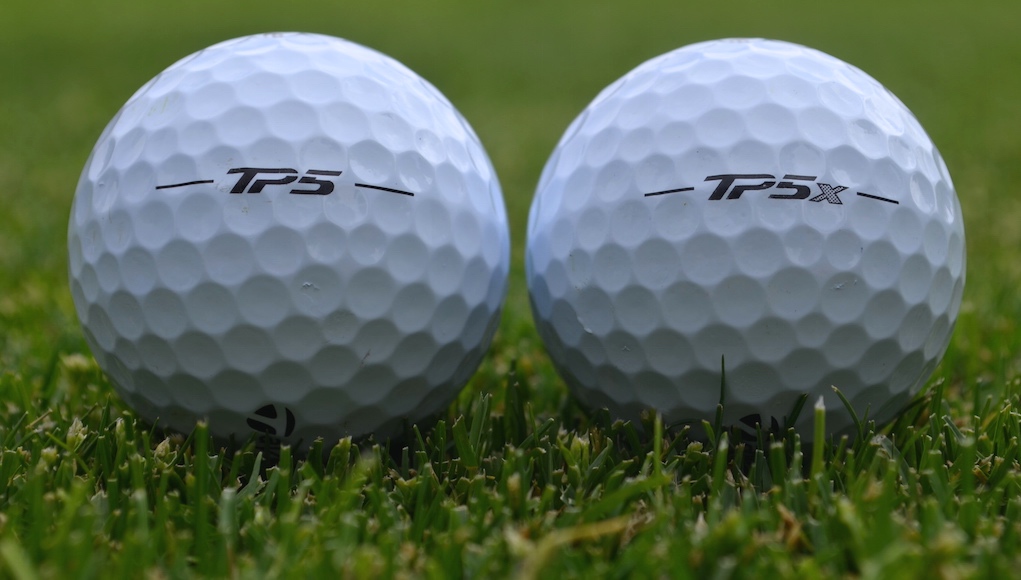
For years now, TaylorMade has been preaching lower spin to create more distance, especially in its drivers. Its original SLDR driver was actually so low spinning that TaylorMade encouraged golfers to try higher-lofted club heads, or to “loft up,” so golf balls wouldn’t dive out of the air. Now, when you look around at the popular drivers in the industry, most of them are designed to lower spin. TaylorMade was ahead of the curve.
With its new TP5 and TP5x golf balls, TaylorMade is pushing a similar initiative: lower spin on all full shots.
“This ball is different. You can make the argument this is too hot a golf ball for people who don’t spin it (enough). But that’s not the large percentage of golfers.”
For driver shots, it’s easy to understand the benefit of lower spin as long as the golfer launches it high enough. Low spin plus high launch equals more distance; that’s just a math equation. But with golf balls, as opposed to drivers, their jobs are also to get close to the hole, not just go as far and straight possible. With that in mind, is lower spin necessarily beneficial on ALL full shots, including the irons?
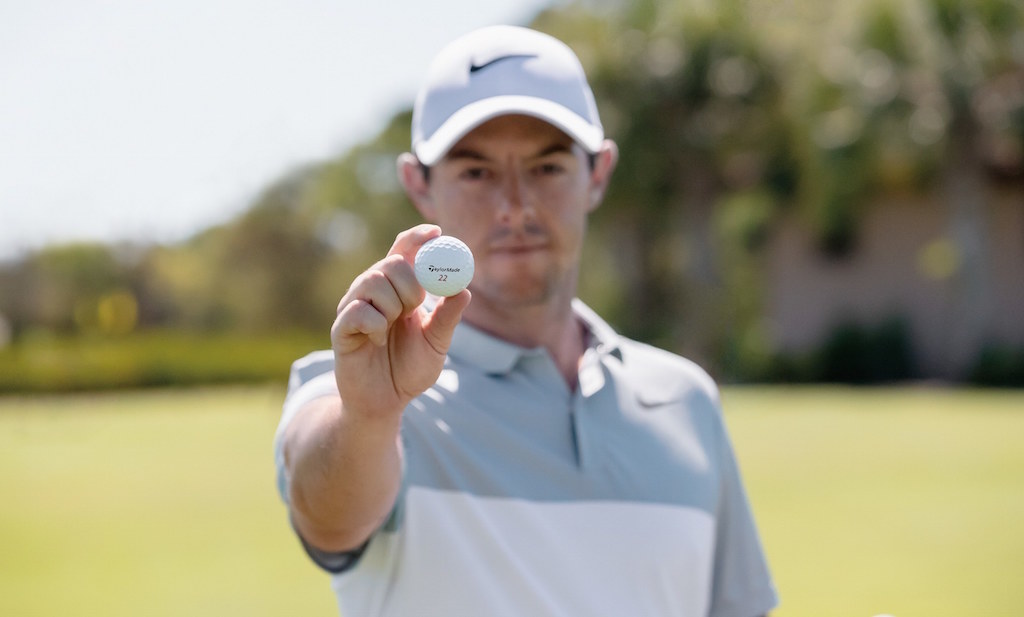
For Jon Rahm and Rory McIlroy, who both switched to TaylorMade TP5x golf ball this season — the lower-spinning and slightly firmer-feeling golf ball in the TP5 line — the answer is clearly “yes.” Rahm saw an 800 rpm drop in iron spin with a 4-iron compared to his Titleist’s Pro V1x golf ball and a 400 rpm drop in driver spin, according to TaylorMade. McIlroy saw up to 10 yards in extra distance with a 5-iron, and he picked up distance with the driver, as well. According to Eric Loper, Director of Golf Ball R&D at TaylorMade, McIlroy was hitting his 7 iron at 16.1 degrees of launch with 6350 rpm, and his 4 iron at 11.1 degrees of launch with 3800 rpm during his initial Trackman testing at The Bear’s Club.
“(With a 7 iron) you have to hit it about 7000 (rpm) or less, and he was hitting (his previous ball) up to 7500 (rpm),” Loper said. “That’s too high… (With the TaylorMade TP5x) he didn’t express any concern with (spin being too low). It was launching high, getting to its apex and landing soft.”
Hoyt McGarity, President of True Spec Golf, an internationally renowned custom club fitter with more than a dozen locations, has seen similar performance gains with TaylorMade’s TP5x golf ball through his personal testing and his testing with Tour players. He said he’s seeing 2-3 mph more ball speed compared to other golf balls. Just as importantly, he’s seeing those gains with a higher ball flight in what he called “straight up” club tests.
“Some of the Tour players — straight up, same loft, same lie, same golf club, same everything — they would launch this golf ball almost a degree higher, which is amazing,” McGarity said. “I was seeing almost 2-3 mph more ball speed for these Tour players, not that they need more distance, but I’m like, ‘You’re launching higher and it’s going further and it’s still coming in soft; it’s not coming in low and hot. It’s coming in high and still soft, so what’s the disadvantage?’ If you’re a low-ball hitter with low spin, you might have some issues. Your half shots might be tough to control the distance on it, that’s all.”
So while TaylorMade’s TP5 and TP5x golf balls are designed to go farther and with less spin on full shots, the company says their steeper landing angles will help them stop nearly as fast as higher-spinning balls. TaylorMade’s belief is based on the company’s scientific bounce-and-roll calculations, which factor in green conditions and landing characteristics. Yes, the lower spin of its golf balls in relation to competitors leads to minimally more roll out, but the amount is insignificant according to TaylorMade: an additional 1-1.5 feet. The company also points out that with a longer-flying golf ball, golfers will be hitting shorter clubs into greens, leading to more control. An 8 iron will yield greater stopping power and accuracy than a 7 iron, right?
Expert fitter Scott Felix of Felix Clubworks agrees with TaylorMade in theory. He said that as long as the golf ball is coming into a green at a steep enough angle, low spin is not a problem for approach shots.
“Most golfers spin the ball too much with their irons, costing them distance,” Felix said, “…but for golfers who already have a flat trajectory (with their irons), lowering spin won’t help them hold the green.”
McGarity added that about 80 percent of golfers who come to him for a fitting spin the ball too much, and for Tour players, the drop in spin won’t have a detrimental effect.
“Lets say the average spin on Tour is 6,000 (rpm with a 6 iron); it’s not like [TaylorMade’s TP5x golf ball is spinning] around 4,000 (rpm),” McGarity said. “If your average land angle is 49 degrees, they’re hitting these balls at say 5800 spin, which I think is great, and with a 50-degree land angle, so what’s the harm? It’s not like it’s coming in at 44 degrees; that’d be probably a one hop over the back and get into a little trouble.”
On the other hand, Felix notes that some Tour players simply want maximum control from a golf ball due to firmer fairway and green conditions, so lowering spin isn’t always the best option for them. But for average golfers, the distance gains will be beneficial.
“Most golfers aren’t playing in Tour conditions and will simply benefit from hitting the ball farther and having shorter irons into the green,” Felix said.
McGarity also warns golfers who already play low-spinning irons and drivers, and who spin the ball below 2,000 rpm with the driver, that the TP5 and TP5x golf balls may not be for them.
“This ball is different,” McGarity said. “You can make the argument this is too hot a golf ball for people who don’t spin it (enough). But that’s not that large percentage of golfers.”
After announcing an equipment contract with TaylorMade at The Players Championship, Rory McIlroy called TaylorMade’s TP5x golf ball the most important factor in his decision to sign with the company. With the new ball, he said he not only picked up distance, but consistency and control in the wind.
“I wasn’t really happy with the golf ball I was playing, and I needed to do something,” McIlroy said. “I felt like I struggled in the wind. So I sort of went back to the drawing board and tested for about 10 days pretty extensively after Augusta … I worked with the TaylorMade guys one day and started just on Trackman on the range and saw stuff with the golf ball … I thought, ‘Wow, this is what I need.’ This is exactly the thing that I’ve been struggling with.”
McGarity’s experiences confirmed McIlroy’s sentiments.
“I picked up a half club and I sit around and hit balls all the time on Trackman, so for me to pick up a half a club, it’s not the club it has to be the ball,” McGarity said. “And into the wind I can definitely see it’s more penetrating. I’m not a super high-spin player, so some shots I’ll hit the ball farther than I expected, but I’d rather have that issue than (to hit it) short.”
So there’s agreement that the ball spins less, goes farther and performs better in the wind with irons. But when fitting a golf ball, is iron play even the best place to start? Golf is about more than just iron shots, after all.
For Felix, a ball fitting begins by having a client hit “a bunch” of different golf balls on the putting green to narrow it down to a few based on feel preferences. Then he has the golfer take those golf balls to the chipping green and bunker. He then works back to 40-yard shots, narrowing down the options throughout the process based on feel and performance. After that, golfers will progress to the driver, and then to the irons.
“Usually you want to get a few balls you really like on and around the greens, then work backwards from there,” Felix said.
Initial testing for McIlroy started on the golf course, and not on Trackman, according to TaylorMade representatives. Once he became comfortable with performance and feel, he then took to Trackman to get dialed in with spin and match the golf ball to his equipment.
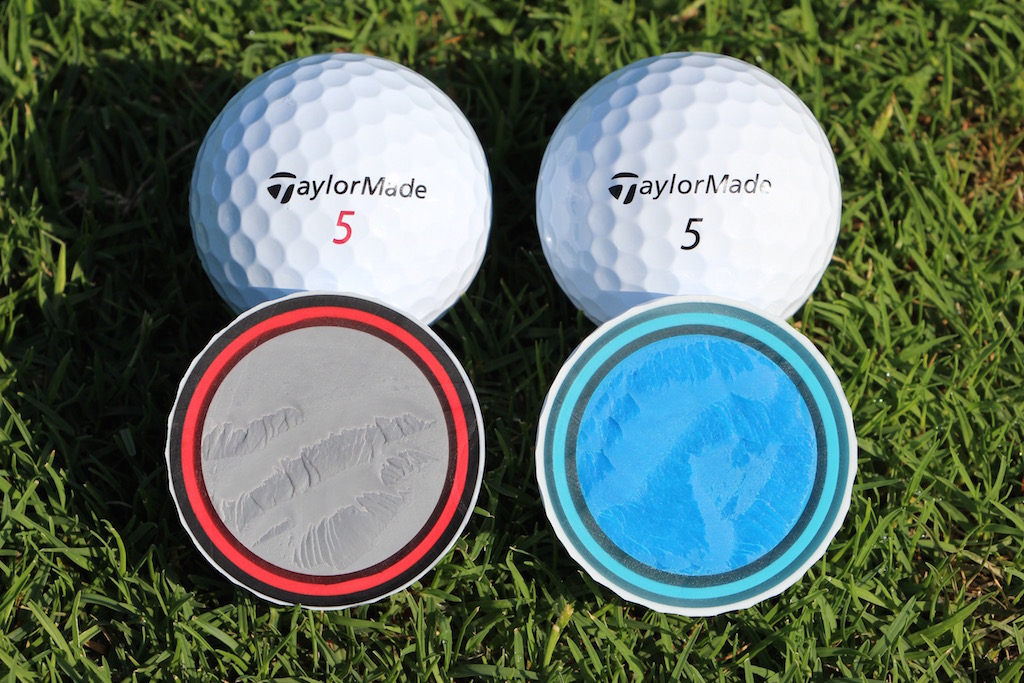
TaylorMade’s TP5x and TP5 golf ball (right), which has a slightly firmer feel.
Despite the low-spinning qualities of the golf balls on full shots, TaylorMade believes it’s giving up nothing to the competition in terms of short game performance. “There’s no golf ball that spins more around the greens,” a TaylorMade representative told me. That’s a legal way of saying no other golf ball company can prove, with confidence, that its golf ball spins more around the greens.
By producing extremely low spin on full shots, but without giving up performance and feel around the greens, TaylorMade says it’s providing the best qualities from each end of the spectrum with its TP5 and TP5x golf balls. But… how? TaylorMade engineers accomplished the feat by using larger and softer-compression cores. TaylorMade says the cores “activate” at 70 mph of swing speed inside of the five-piece constructions, which also have firm mantle layers and soft, urethane covers. The result is low spin on full shots, and high spin on shorter shots.
“It’s the real first golf ball (TaylorMade has) made that’s a game changer,” McGarity said.
TaylorMade does admit, however, that golfers may be sacrificing a bit of “workability” with the irons. That’s to say hitting hooks and slices with its golf balls becomes more difficult due to the lower spin. While the TP5 will offer a bit more of that control than the TP5x, it’s definitely something to keep in mind for those who prefer to play a Bubba Watson-style of golf.
Looking to the future
So does all of this mean that lower-spinning golf balls on full shots are the future of golf? Will we see golf equipment companies striving for drastically lower spin over the next few years?
TaylorMade representatives say they continue to chase lower spin in their prototyping, and until the golf ball is diving out of the air to the golfer’s detriment, lower spin is the future of golf balls. Obviously, TaylorMade is fully committed to a lower-spinning golf ball, and lower spin in general throughout its product lines.
For other premium golf ball manufacturers, bringing lower-spinning options to the market seems likely, given the performance benefits and Tour validation of TaylorMade’s new golf balls. But there’s a reason there are so many variations of golf balls on the market; every golfer is different. Some need more spin with the driver and want more workability with the irons, some want a super firm feel and others just want the cheapest ball possible.
Golfers should view TaylorMade’s TP5 and TP5x golf balls as options in the vast marketplace of golf balls, and perform thorough testing to figure out if this is the right line of golf balls for their game. And remember, lower spin and more distance will require recalibrating your iron distances, and possibly adjusting your equipment, so a mid-season switch is recommended only to those who are willing to put in the necessary work.
- LIKE311
- LEGIT52
- WOW18
- LOL8
- IDHT2
- FLOP6
- OB2
- SHANK79
Ball Reviews
Review: Callaway Chrome Soft X Golf Balls
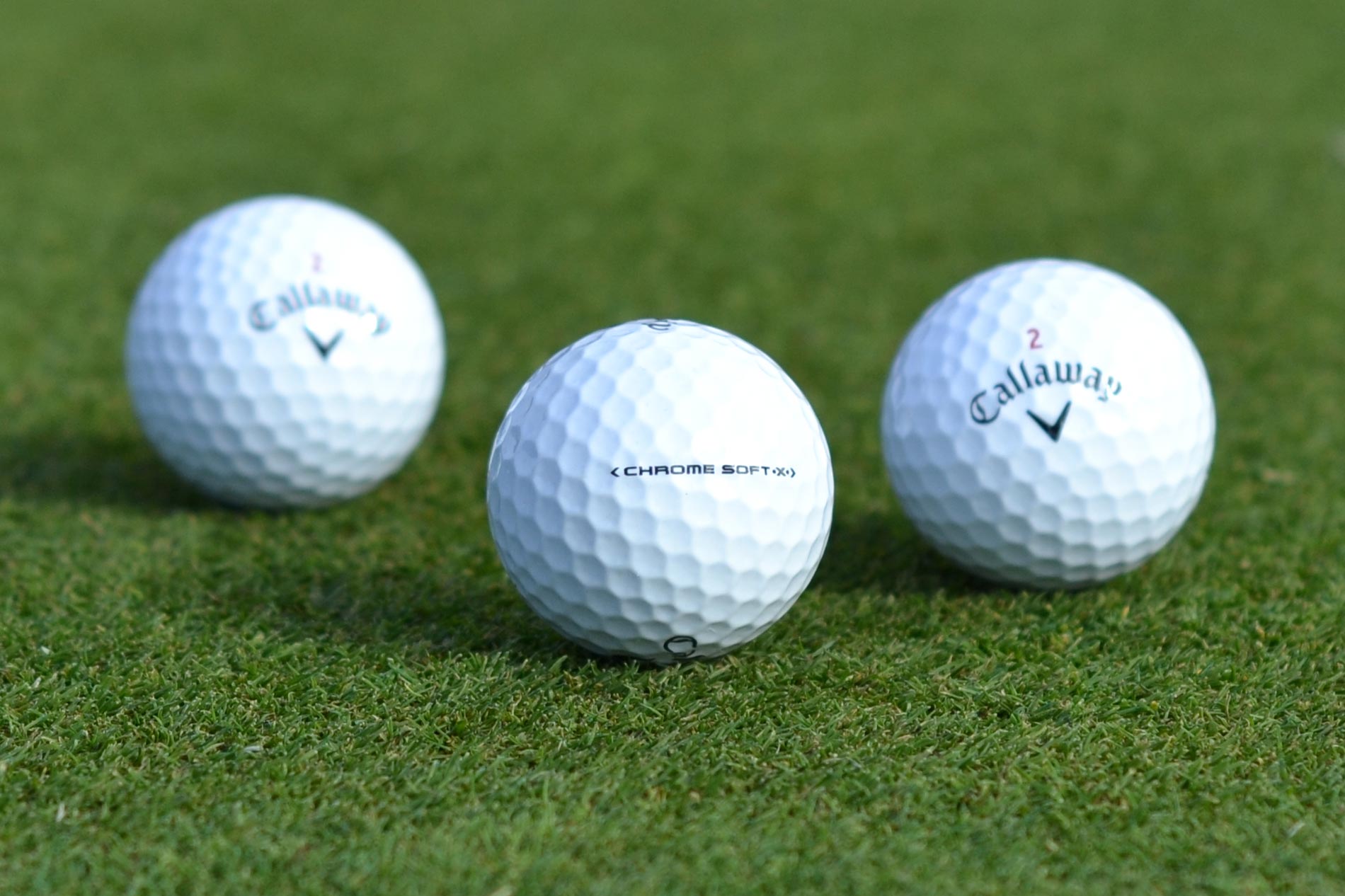
Pros: Incredibly soft feel like the Chrome Soft, but the Chrome Soft X increases spin through the bag to give better players more control.
Cons: Golfers who struggle with too much slice or hook won’t find it any easier to keep shots close to the target with the Chrome Soft X.
Who They’re For: Better players with higher swing speeds looking for a soft-feeling ball that checks up faster with iron shots than Chrome Soft.
The Review
Callaway says the Chrome Soft is “the ball that changed the ball,” and in many ways that’s true. It’s a tour-level golf ball with a softer feel, less spin through the bag and even a lower price point ($39.99) than some other tour balls in its category.
The Chrome Soft is Callaway’s best ball option for the vast majority of golfers (and received a 5-star rating by GolfWRX), but it isn’t for everyone. Callaway’s solution for them is its new Chrome Soft X golf ball.
What’s New in the Chrome Soft X
The original Chrome Soft golf ball, launched in 2015 had the very soft compression of 65. When Callaway released the 2016 version of Chrome Soft, it gave the ball a slightly higher compression (75), which improved its consistency on short-iron shots. The compression of its new Chrome Soft X is 90.
The reason for the higher compression has to do with the low-spin profile of the Chrome Soft, a blessing to most golfers as it helps their shots fly straighter and farther. It’s not ideal for some tour pros and better golfers, however. We’re talking about the kind of golfers who have great mechanics and strike shots consistently on the center of the club face. They often have a ball flight that is so dialed in that the lower-spinning performance of the Chrome Soft makes their shots harder to control. To address that small but important segment of the golfing population, Callaway created the higher-spinning Chrome Soft X.
Under the hood, Callaway used a slightly thinner urethane cover, increased the size and hardened the compression of the Dual SoftFast core, and enhanced the HEX Aerodynamics. As a result, the Chrome Soft X should generate more ball speed and spin through the entire bag.
Dave Bartels, Callaway’s Senior Director of Golf Ball R&D, says golfers will be able will notice the differences and have a clear favorite. “We expect that golfers who like the Chrome Soft X probably won’t like the Chrome Soft very much, and vice versa.”
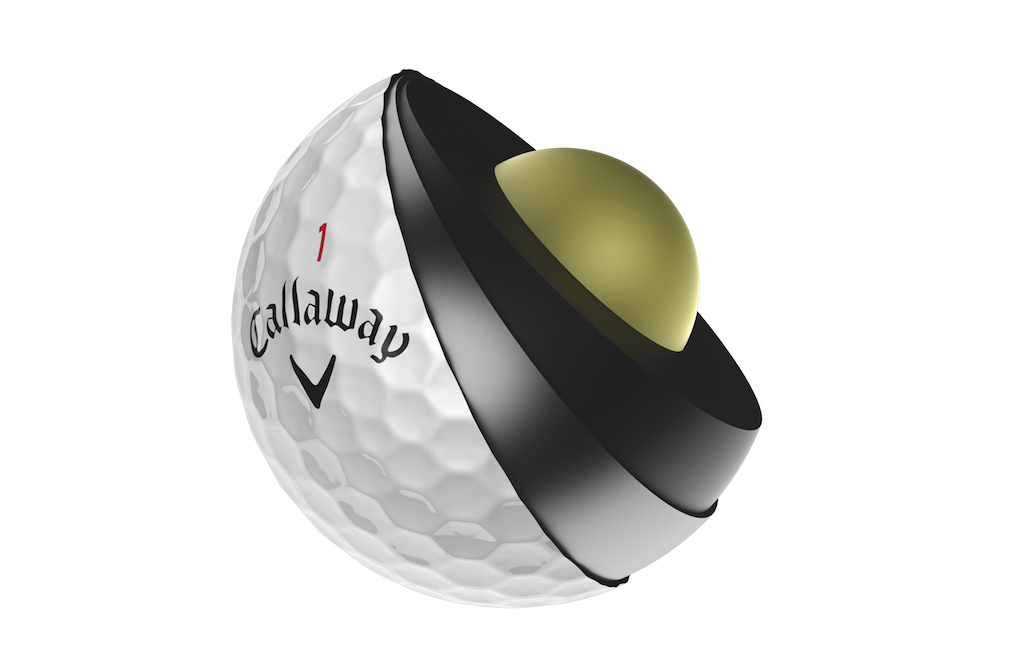 The Chrome Soft X ($39.99) will be in stores February 3 in White and Yellow.
The Chrome Soft X ($39.99) will be in stores February 3 in White and Yellow.
Performance
Since the Chrome Soft X is meant to be a complimentary golf ball to the Chrome Soft, we tested them head-to-head.
Compared to the Chrome Soft the Chrome Soft X should:
- Feel almost as soft as the Chrome Soft with the same durability.
- Generate more spin where better golfers need it.
- Generate faster ball speeds.
Like previous reviews, I tested these on the course and on a launch monitor with a 60-degree wedge, 6-iron and a driver. To allow me to re-hit each ball numerous times, I completed the testing indoors on a camera-based SkyTrak launch monitor. To keep the numbers as consistent as possible between the balls, I threw out and re-hit any shots that were not struck on the center and did not land within a designated target zone for each club (Wedge: +/- 3yards, 6 Iron: +/- 8 yards, Driver: Target width of 40 yards).
But I’m not a robot, so take that into account.
60-degree full wedge shots
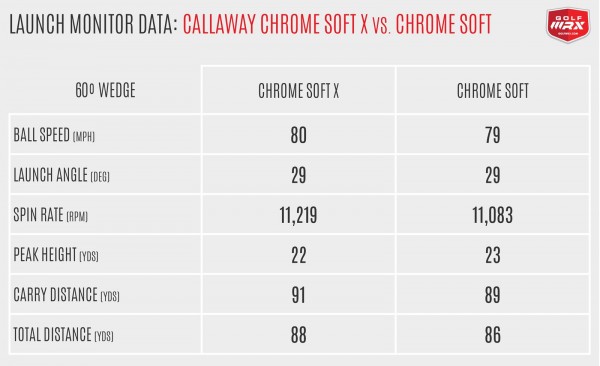 Main differences we expect to see: Not many. If anything, the Chrome Soft X might generate slightly higher ball speeds.
Main differences we expect to see: Not many. If anything, the Chrome Soft X might generate slightly higher ball speeds.
What the data actually shows: Pretty much as expected. Overall, the Chrome Soft X clocked 1 mph more ball speed, 136 rpm more spin and carried 2 yards farther. These are very subtle differences, and for an amateur like me I would not expect to notice a difference on the course.
The larger Dual SoftFast core and higher compression could account for the additional ball speed and carry distance. For me, 2 yards won’t require much of an adjustment. If you are a better player completely dialed in with your distances, you might need to make a minor adjustment.
What I saw on the course: When I’m testing golf balls, I like to drop one down without looking at the label and hit a shot. This allows me to remain unbiased in my expectation and just watch what the ball does. When I did this test with the Chrome Soft X on a full wedge shot, I was instantly impressed. The feel was incredible and the distance was spot on. After the wedge testing, I would’ve put this ball straight in the bag.
6-iron shots
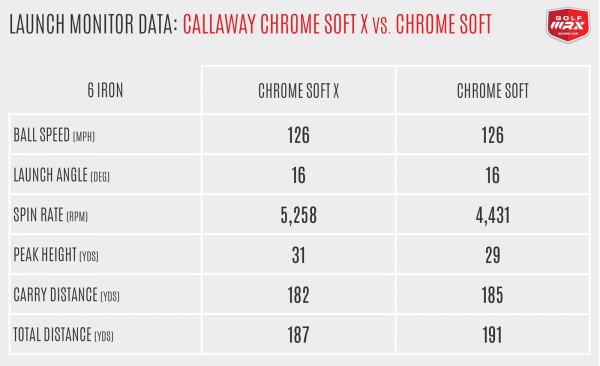 Main differences we expect to see: The Chrome Soft X should generate faster ball speeds and more spin than the Chrome Soft.
Main differences we expect to see: The Chrome Soft X should generate faster ball speeds and more spin than the Chrome Soft.
What the data actually shows: The Chrome Soft X is continuing to spin more through the bag. Ball speeds were slightly higher by about 0.8 mph. The Chrome Soft X generated a considerable amount of additional spin, but also flew slightly higher and had a steeper descent angle.
Just like you’ll see with the driver below, the additional spin decreased my distance (the Chrome Soft X averaged 3 yards less carry and 4 yards less total distance), but increased my stopping power.
What I saw on the course: Just like previous Chrome Soft balls, the feel off the club face with mid irons was very soft. I really noticed the additional spin on the course, as my draw shot shape started to get a little more curve to it and my shots stopped faster on the greens. I felt like I was able to attack greens with longer irons, flying shots all the way to the hole instead of playing a little short and letting the ball release more.
Driver shots
Main differences we expect to see: The Chrome Soft X should spin more slightly more and deliver higher ball speeds than the Chrome Soft.
What the data actually shows: I am not a high swing-speed player. My average playing swing speed is around 105 mph, which is generally considered the cut-off before you have a “high swing speed.” Also, I am not a low-spin player, so having a ball that can spin a little more might not be the best for my specific game. Based solely on that, I would not expect to see the full benefits of the Chrome Soft X
The testing backs this up. The Chrome Soft X delivered the same ball speed, but with 432 rpm more spin. Bartels says Callaway’s testing has shown golfers either spinning the Chrome Soft and Chrome Soft X the same off the tee, or an increase of 100-200 rpm with the Chrome Soft X. He called 400 rpm “within the ballpark,” but not typical.
Just to be clear, we’re talking about a change in performance that resulted in just 1 yard less carry distance and 3 yards less total distance; basically nothing.
What I saw on the course: As my launch monitor data showed, the Chrome Soft X appeared to fly higher and not roll as much when it hit the ground.
The one place I saw a benefit to the Chrome Soft X was when I contacted a drive high off the club face. With the Chrome Soft, these drives fell out of the sky more quickly, costing me carry distance. With the Chrome Soft X, they stayed in the air a little longer. It’s clear for low-spin players, or those with already optimal launch conditions, the Chrome Soft X can provide as good, if not better performance.
Around the Green
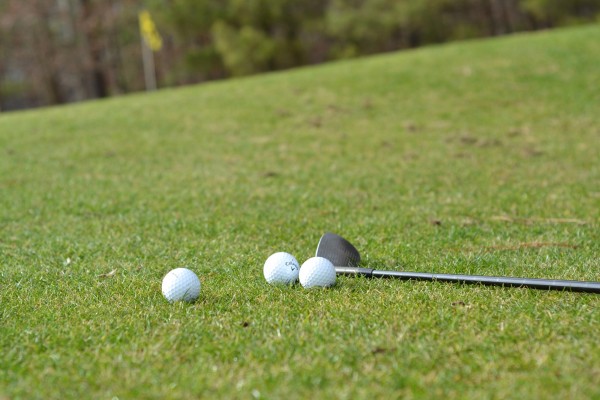 There is nothing this ball can’t do around the greens. I don’t have a tour pro’s arsenal of short game shots, but I do know the difference between a ball that can do anything and a ball that can do only some things.
There is nothing this ball can’t do around the greens. I don’t have a tour pro’s arsenal of short game shots, but I do know the difference between a ball that can do anything and a ball that can do only some things.
I put the Chrome Soft X through the paces of low spinners, high flop shots, bump and runs, and bunker shots. As expected, it performed identically to the Chrome Soft.
Putting
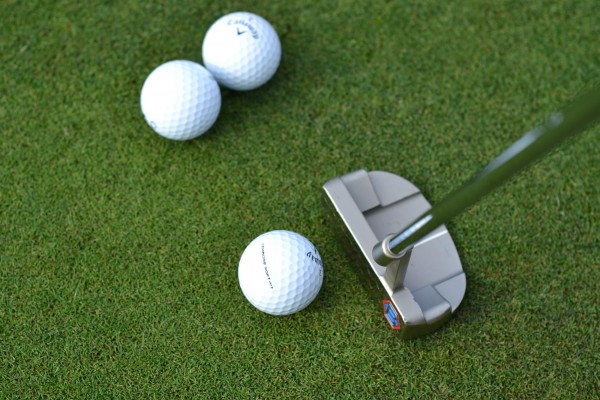 Putting one right after the other, if you are really paying attention, the Chrome Soft X feels slightly firmer off the putter face with a slightly higher-pitched sound than the Chrome Soft. But this ball is soft, smooth and rolls beautifully. I have always loved the way the Chrome Soft feels off the putter, going back to the 2015 ball. Even though it’s slightly firmer, the feel off the putter of the new Chrome Soft X continues to impress me (through the entire bag really).
Putting one right after the other, if you are really paying attention, the Chrome Soft X feels slightly firmer off the putter face with a slightly higher-pitched sound than the Chrome Soft. But this ball is soft, smooth and rolls beautifully. I have always loved the way the Chrome Soft feels off the putter, going back to the 2015 ball. Even though it’s slightly firmer, the feel off the putter of the new Chrome Soft X continues to impress me (through the entire bag really).
Feel is subjective, but I found the Chrome Soft X to be one of the softest tour balls on the market today.
Durability
I completed all my testing with only one ball, so it saw a considerable amount of shots. Like previous Chrome Soft balls, the Chrome Soft X is very durable. It took a beating with the 60-degree and showed only light scuff marks. Both the Chrome Soft X and the Chrome Soft perform very similarly in terms of durability.
The Takeaway
The Chrome Soft X isn’t for everyone and that is why Callaway is marketing the “X” as a complimentary ball to the Chrome Soft and not a replacement.
With the changes Callaway has made, the Chrome Soft X checks off all the criteria for a high-performance premium golf ball. If you thought the 2016 Chrome Soft was a little too soft with too little spin through the bag, the Callaway Chrome Soft X might just be the ball you’re looking for.
- LIKE294
- LEGIT43
- WOW14
- LOL8
- IDHT4
- FLOP8
- OB3
- SHANK25
Ball Reviews
Review: Callaway Chrome Soft golf balls
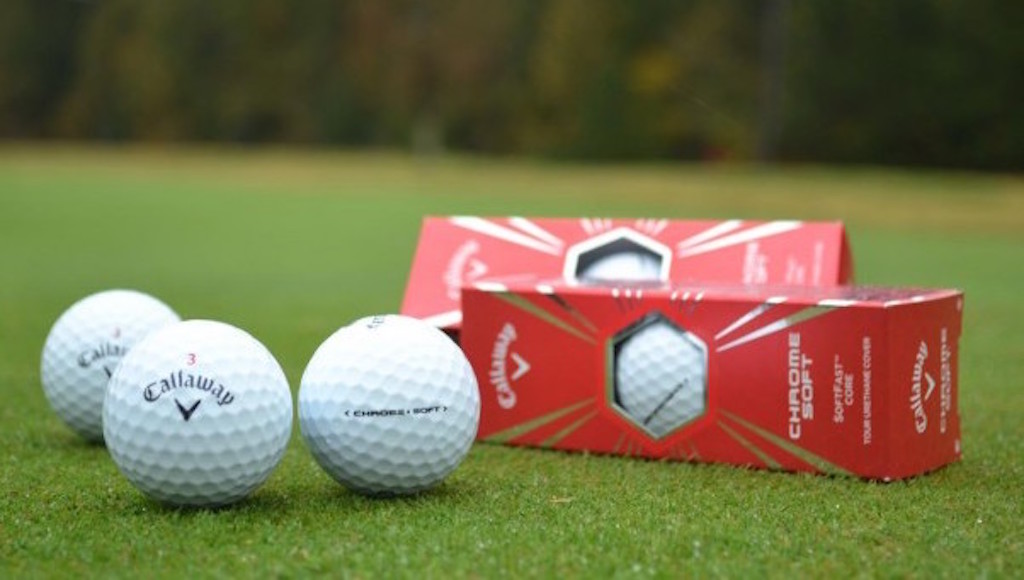
Pros: The Chrome Soft has an incredibly soft feel, but doesn’t skimp on performance. It will create maximum distance off the tee for 99 percent of golfers, yet offers short-game spin that rivals more expensive models.
Cons: Golfers with high swing speeds (105+ mph) — a.k.a. the 1 percent — may lose a few yards off the tee due to the Chrome Soft’s low-compression design.
Who They’re For: Any golfer can play the Chrome Soft.
The Review
Last year, Callaway released the Speed Regime golf ball line, which offered three different golf balls designed for different swing speeds, all with slightly different levels of compression and design. While this gave golfers the ability to really “fit” a golf ball to their game, more choices doesn’t always translate into better decision-making.
With its new Chrome Soft golf balls, Callaway has released just one ball, with one set of specifications, designed to provide a benefit to all golfers regardless of their swing speed.
The three-piece Chrome Soft, with a low-compression Soft Fast core and extremely soft DuraSpin cover, generates lower spin off the driver and long irons for more distance, while generating tour-level spin with shorter irons and shots around the green.
Let’s Talk Core
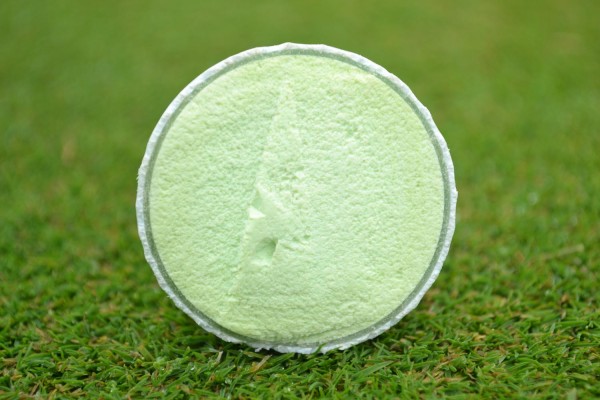 The Chrome Soft is all about the core, and since Callaway is devoting advertising space to actually talking about the compression of the golf ball, let’s dig into it a bit more.
The Chrome Soft is all about the core, and since Callaway is devoting advertising space to actually talking about the compression of the golf ball, let’s dig into it a bit more.
Thanks to a brand new SoftFast core, as Callaway calls it, the ball has a compression rating of 65. By comparison, last year’s Callaway SR-3 had a compression of around 105. Typically, the softer the core, the more the ball deforms at impact. This is great for slower swing speed players who need the ball to deform more so it can spring back into shape and generate more distance. But faster swing speed players can actually lose distance if the ball is too soft. After experimenting with 39 different prototypes, however, Callaway was able to create the right combination of the core and mantle layer so the Chrome Soft retains the energy from impact and keeps ball speed high — even at faster swing speeds.
The Chrome Soft is available now in White, Soft Yellow and Truvis Technology with an MSRP of $37.99. Custom player numbers and personalization is also available.
Performance
We put the new Chrome Soft to the test against the Callaway Speed Regime SR-3, which I tested last year.
Compared to the Speed Regime line the Chrome Soft should:
- Feel softer off every club, with slightly better durability.
- Generate less spin off the driver.
- Create more spin off shorter irons.
Like all reviews, I tested these on the range, on the course, and on a launch monitor with a 60-degree wedge, 6-iron and a driver. I headed to BridgeMill Golf Academy and worked with head pro Tom Losinger to get the data using a Trackman in his indoor studio.
60-degree full wedge shots
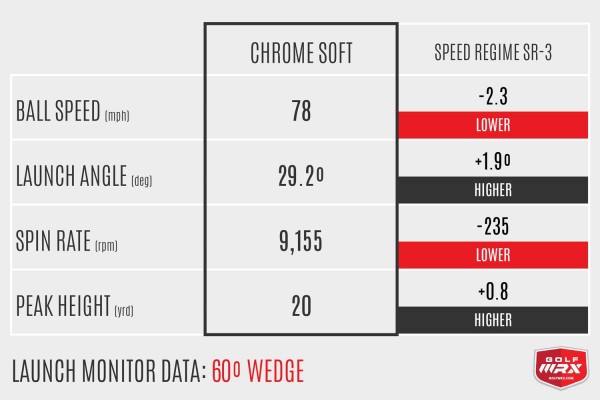
Main differences we expect to see: The Chrome Soft should generate more spin on full wedge shots.
What the data actually shows: Exactly what we expected to see. The Chrome Soft generated 200 rpm more spin than the SR-3, while launching lower and hitting a slightly lower peak height. I did, however, see a big difference in ball speed and carry distance, with the Chrome Soft flying three more yards on average.
Increased ball speed or carry distance with the shorter irons is not typically on the list of requests from better players. In this case, it’s a by-product of the new SoftFast core and three more yards of carry with a 60-degree wedge is fairly significant. That 10-foot putt for birdie is now almost 20. These types of gains will require an adjustment.
What I saw on the course: This ball was perfect inside 100 yards. If it was flying farther than other balls I’ve played, I didn’t notice. The trajectory on full wedge shots was nice and low compared to other balls, and I was already able to notice a difference in feel between the Chrome Soft and the SR-3. A difference of 200 rpm of spin wasn’t noticeable on the course, as both balls performed very similarly when they hit the green.
6-iron shots
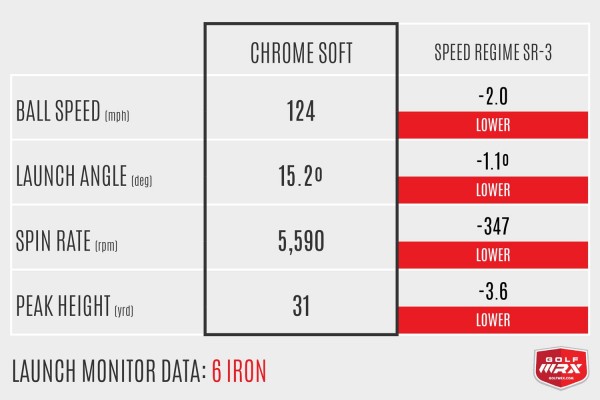
Main differences we expect to see: The Chrome Soft should generate faster ball speeds and less spin than the SR-3.
What the data actually shows: The data backed up the expectations when it came to ball speed. However, I actually saw more spin on my 6-iron compared to the SR-3 and even other tour balls. This could be due to a variety of factors concerning my individual swing, and other golfers might see less spin off their mid irons. Compared to the SR-3, the Chrome Soft launched a little higher, with more spin and ball speed, allowing it to carry a little more than one yard farther. It also hit a higher peak height with a steeper descent angle.
What I saw on the course: I was probably most impressed with the Chrome Soft with the mid to long irons. Yes, the ball performed great off the driver, but the softer feel was very apparent with an iron in my hands. Launching shots with mid to long irons had a more effortless feel. I was also able to get some nice height and spin on my longer irons without sacrificing distance, so I could land shots on the green and see them stick, instead of hitting and running off the back.
Driver shots
Main differences we expect to see: The Chrome Soft should spin less, but still generate more ball speed than the SR-3.
What the data actually shows: I’m a borderline high-speed guy with the driver. My average swing speed is around 106 mph — right on the borderline where golfers can start to “over-compress” the Chrome and possibly lose distance.
You may have read editor Zak Kozuchowski’s reviews on GolfWRX, who can generate more than 115 mph of swing speed with his driver. In his on-course testing, he said he hit the Chrome Soft about the same distance as other tour balls.
“If they liked everything else about the ball, I can’t imagine a golfer who swings 105+ mph wouldn’t play the Chrome Soft just because it was a few yards shorter than a higher-compression tour ball off the tee,” he said. “If a soft feel is important to them, that’s going to take precedence over a few yards of extra distance. And they’ll get those few yards back with their long irons, anyways.”
In my testing, the Chrome Soft generated slightly faster ball speeds, and a lot less spin — almost 300 rpm less spin than the SR-3. This translated into an extra 1.5 yards of carry, and more than 5 extra yards of total distance.
What I saw on the course: The distance gains and lower spin appeared to translate to the course. I wasn’t having any issues getting the ball to run out once it hit the fairway. And the distance appeared to be spot on, if not slightly longer.
Around the green
It is always fun to have that moment in a round where you hit the low, checking chip that freaks out your playing partners. I had that moment from about 55 yards away to a back pin, with out of bounds directly behind the green. With a 56-degree wedge, I hit the low shot and right before the ball hit the green, my playing partners were yelling “get down!” But I knew I hit it well and the ball bounced, checked, and then just lipped the cup.
Could I have executed that shot with other tour balls? Yes. But, it is important to know I can execute it with the Chrome Soft. I’m not a short-game wizard like one of Callaway’s more well-known tour pros, but these balls allow me to hit any kind of shot around the green without hesitation.
Putting
The Chrome Soft feels much softer than the SR-3, which was noticeably softer than previous generation Callaway tour balls. The sound profile has a lower, less “clicky” sound that translates into improved feel. The engineers really have brought the incredible feel of the SuperSoft to the tour-level Chrome Soft.
I’ve rolled some beautifully smooth putts with these balls. They are predictable and roll true when you strike them well. While I won’t go so far as to say they are the best feeling golf ball on the market (although they are close), they are the best feeling Callaway golf ball I’ve tested.
Durability
When most people hear “softer cover,” they instantly assume it will be less durable — and for good reason. It is counter intuitive to believe that soft equals durable. I’m not going to pretend to know the science behind it, but the DuraSpin cover is made from Thermoplastic Urethane, which actually becomes more durable the softer it gets.
I’ve played numerous rounds with the same ball, and also completed all the testing with only three Chrome Soft golf balls, so I can back up Callaway’s claims. These balls are definitely durable and can last numerous rounds if you don’t lose them. With fresh wedge grooves, I was getting all the spin benefits and little to no scuffing. I did see some minor scuffs after finding some rocky rough off the tee, but the ball was still playable and I shouldn’t have been over there in the first place!
The Takeaway
If you’ve avoided Callaway balls in the past because of the “clicky” stigma that has followed them around, it might be time to try a sleeve of the Chrome Soft. Many golfers, myself included, really love the feel of the Callaway SuperSoft, but not the overall performance. The Chrome Soft is a marriage of the soft feel of the SuperSoft with the tour-level performance of the Callaway SR-3. With low spin off the driver and the most spin on short irons of the tour balls I’ve tested this year, the Chrome Soft is one of the best golf balls on the market today.
We gave the Chrome Soft 5 stars, but one of our editors made the case that on a scale of 1-10, the Chrome Soft is an “11.” If you’ve seen the movie Spinal Tap, you know what he means.
See what GolfWRX Members had to say about the Chrome Soft in our Official Forum Testing Thread.
[wrx_retail_links productid=”12″]
- LIKE267
- LEGIT34
- WOW18
- LOL3
- IDHT5
- FLOP1
- OB2
- SHANK24
-

 19th Hole2 weeks ago
19th Hole2 weeks agoDave Portnoy places monstrous outright bet for the 2024 Masters
-

 19th Hole2 weeks ago
19th Hole2 weeks agoTiger Woods arrives at 2024 Masters equipped with a putter that may surprise you
-

 19th Hole2 days ago
19th Hole2 days agoJustin Thomas on the equipment choice of Scottie Scheffler that he thinks is ‘weird’
-

 19th Hole2 days ago
19th Hole2 days ago‘Absolutely crazy’ – Major champ lays into Patrick Cantlay over his decision on final hole of RBC Heritage
-

 19th Hole3 weeks ago
19th Hole3 weeks agoReport: Tiger Woods has ‘eliminated sex’ in preparation for the 2024 Masters
-

 19th Hole1 week ago
19th Hole1 week agoTwo star names reportedly blanked Jon Rahm all week at the Masters
-

 19th Hole1 week ago
19th Hole1 week agoReport: LIV Golf identifies latest star name they hope to sign to breakaway tour
-

 19th Hole1 week ago
19th Hole1 week agoNeal Shipley presser ends in awkward fashion after reporter claims Tiger handed him note on 8th fairway





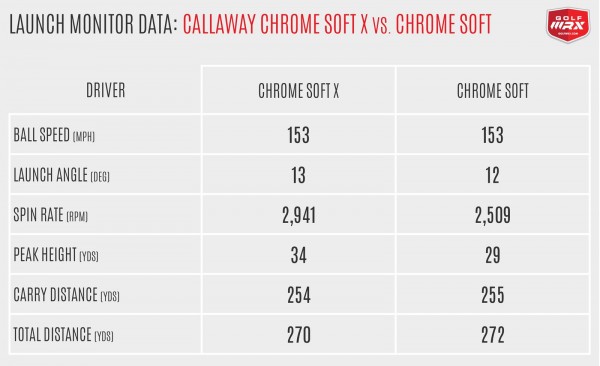
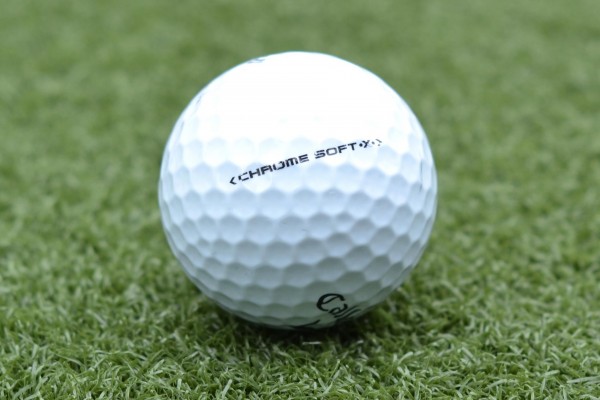
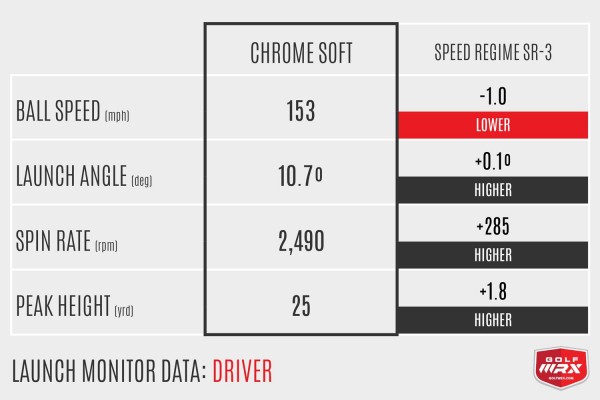
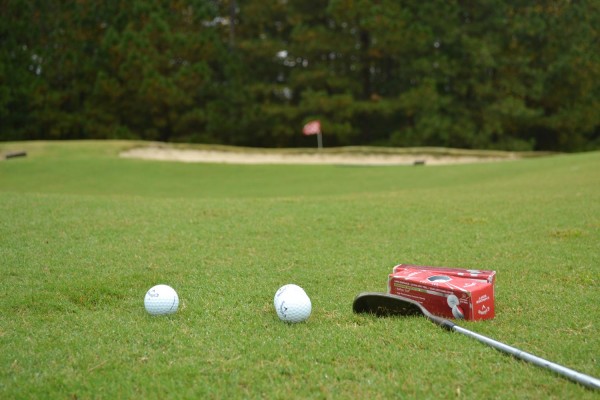
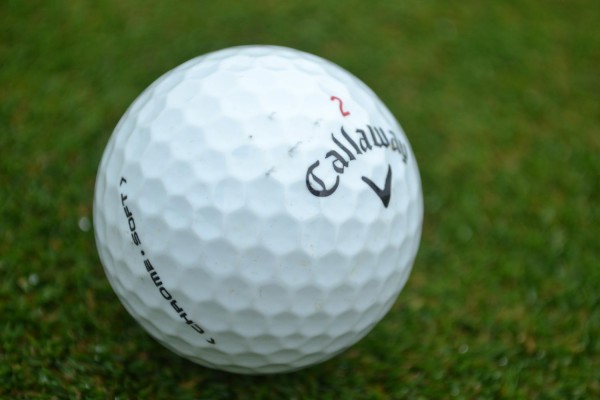












Jonhix
Oct 6, 2012 at 11:03 pm
There are many people in the salagve business of retrieving golf balls but I have not heard of any company which will take a ball , reduce it to its components and make a new ball from the material. With today’s technology, the different construction methods have eliminated the repaints and to a great extent, the refurbish business. With the greater number of balls manufactured and the hawks who scour the woods and water for lost balls, there are enough used balls which are in excellent condition which you can purchase at a reasonable price.
Andy Goloskof
Sep 4, 2008 at 2:19 pm
Excellent article. Great help to our students in their research into the science oof golf balls. Thank You!
Claus
Jul 31, 2007 at 5:35 am
Really thorough review – very well done !
This is my next winter ball of choice 🙂
Mike
Jul 31, 2007 at 12:13 am
great review! thanks for answering all my questions then some
andy park
Jul 26, 2007 at 12:39 am
Great review! Thanks alot! I had questions about the durability of the balls as well. Thanks for a very thorough review!